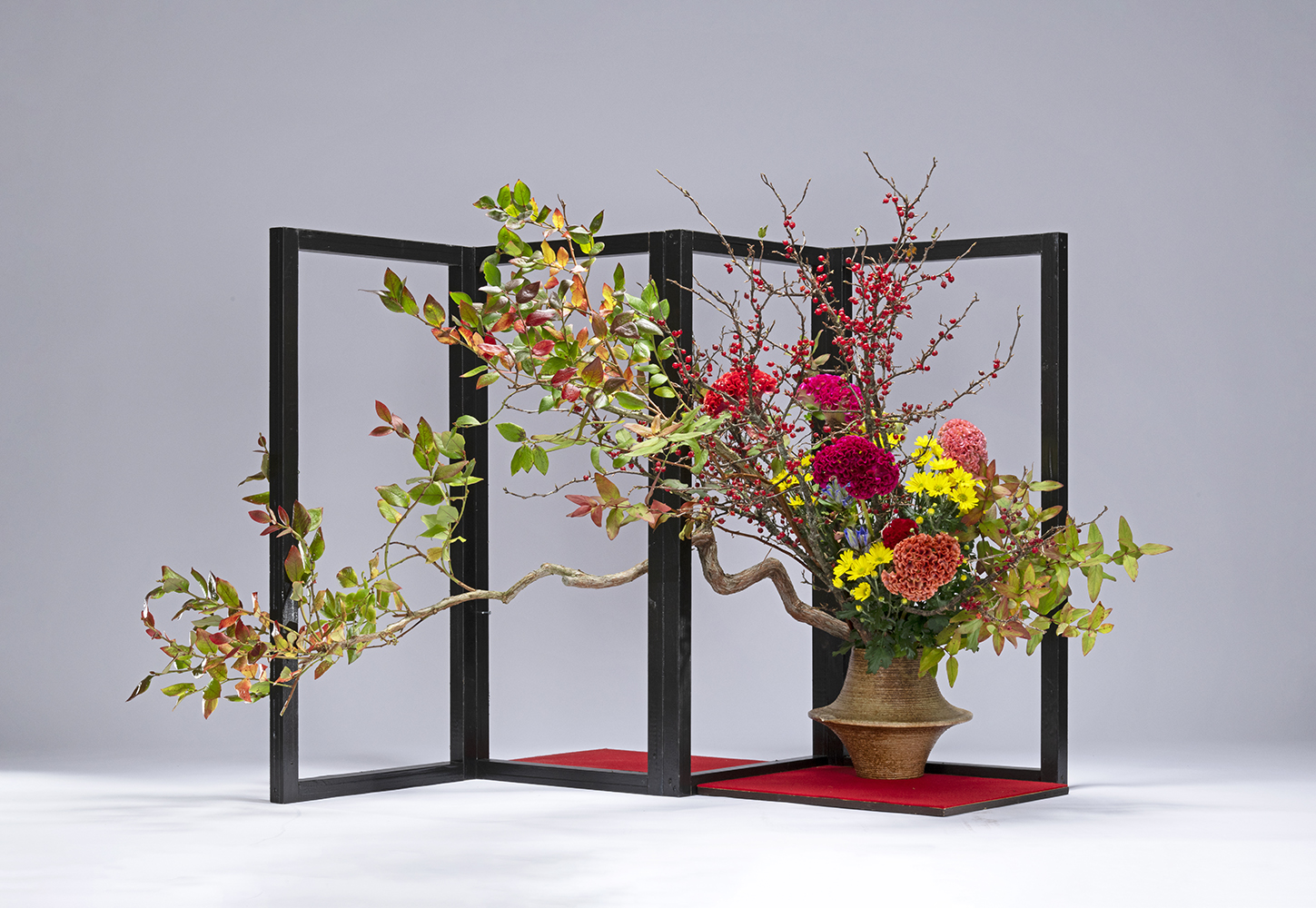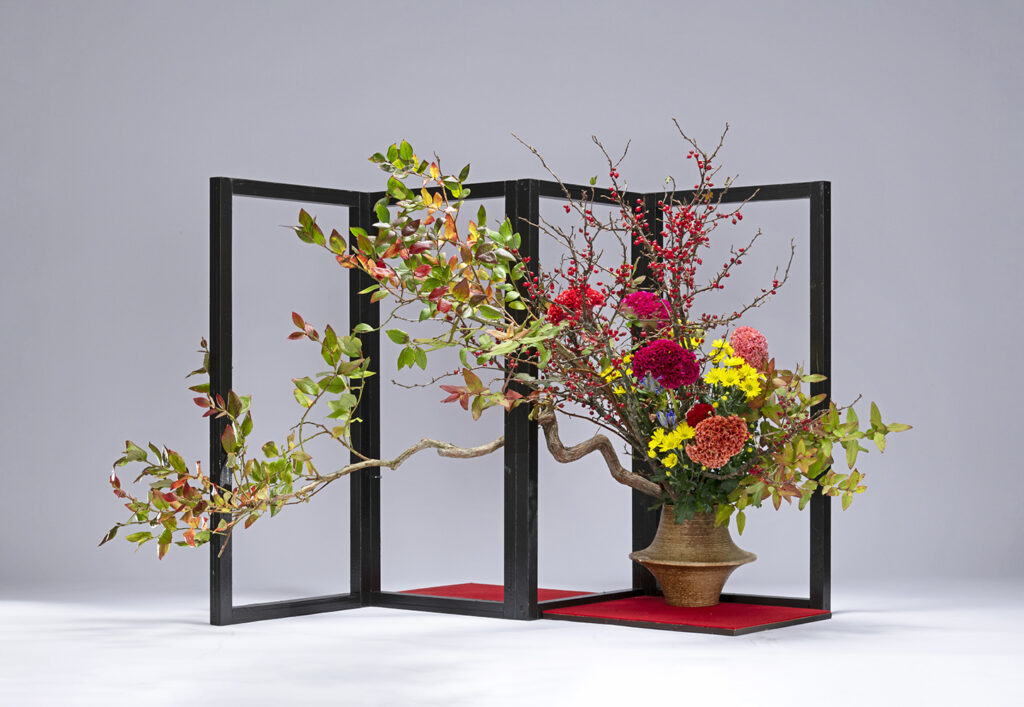
At first glance, the slanted bamboo appears unstable. However, it is a tranquil beauty filled with tension, created through meticulous calculation and delicate sensibility. In the works of flower arranger Naohiro Kasuya, contrasting elements such as lightness and strength, bold movements and delicate textures coexist gracefully. What Kasuya finds in flowers is their unique ‘individuality.’ He is particularly drawn to flowers and branches that have survived harsh environments, as he sees in them the strength of life and the depth of expression that mirror life itself. As a custodian of traditional culture, Kasuya is expanding the boundaries of ikebana and redefining the relationship between flowers and people. His quiet challenge, which moves between tradition and innovation, poses new questions about the nature of beauty in the modern age.
Q: Mr. Kasuya, you studied under Akihiro Kasuya, the third head of the Ichiyo-style ikebana school, from a young age. Is there any teaching you received from your master that you still cherish today?
‘To face things with purity.’ When arranging flowers, I was taught not to bring in unnecessary thoughts such as, ‘If I do this, people will think it’s amazing’ or ‘People will think I’m good at this.’ What’s important is to face directly what you want to express and how you want to arrange the flowers. Otherwise, the work becomes muddled. It’s important to follow your heart honestly and show how you engage with the plants.
Q: Please tell us about the characteristics of Ichiyo-style ikebana.
Before Ichiyo-style ikebana was established, the main schools of ikebana did not use textbooks and generally taught by word of mouth. As a result, there was a gap between those who progressed quickly and those who did not, and the compatibility with the teacher greatly influenced the outcome. In response, the predecessor of Ichiyo-style ikebana, ‘Ichiyo-style flower arrangement,’ was the first to introduce textbooks and curricula in free-style ikebana (a style of ikebana that is not bound by form, but rather seeks to discover the beauty of plants from various perspectives and arrange them freely). To arrange flowers freely, a solid foundation is essential, and the system of learning that allows one to progress steadily and efficiently from the basics was a major feature of the school’s founding. The current Ichiyo-style ikebana upholds the philosophy of ‘hana hazama’ (space between flowers), which was taught by the previous generation. This refers to the attitude of being conscious of one’s own ‘space’ when arranging flowers and deeply capturing their charm and expression.
Q: Has there been a turning point in your ikebana career?
I had been helping my father since I was a child, but I first considered making ikebana my career when I was a third-year university student. As the second son, I didn’t think I would inherit the family business, so I started job hunting like everyone else and went to several company interviews. However, my generation was in the midst of what is known as the ‘employment ice age.’ As rejection letters kept coming in, I decided to change my mindset and submitted a work to the ‘New Generation Exhibition’ organised by the Japan Ikebana Art Association.
Q: What kind of work did you submit?
My father often created works using bamboo, and I helped him with the production. In that process, an idea came to me. Bamboo, if cut at the right joints, can form a base and be used as a vase. However, bamboo that has been cut into a cylindrical shape without joints has no practical use and is mostly discarded. I felt a connection between the bamboo, which is discarded based on superficial impressions without considering its inner beauty, and my own experience of being rejected. When you look closely at cylindrical bamboo, both the surface and the interior have a lustrous beauty. So, I split the bamboo and arranged it by slightly shifting the positions, aiming to highlight the beauty of both the exterior and interior. Through creating this work, I began to believe in the possibility of achieving deeper expression through ikebana.

Q: In Ichiyo-style ikebana, you sometimes consider metal as a material for flowers, in addition to grasses, flowers, and trees. What criteria do you value when selecting materials for flowers?
I look at the expression of the material. People often say, ‘It has a certain charm,’ but what I value is finding that ‘charm’ within the material. Here, “charm” does not refer to mere visual beauty, but rather something like ‘individuality.’ In that sense, I tend to choose flowers that are a bit quirky. This is because flowers that have grown in harsh environments tend to have richer expressions. For example, flowers that have grown on a cliff edge strive to grow upwards despite the adverse conditions. Such flowers exude a dignified strength and bravery that I find very appealing. On the other hand, flowers that have been grown in a greenhouse tend to lack expression and feel somehow lacking. Perhaps there is a parallel with humans.
Q: Have you come across any interesting floral materials recently?
At the demonstration for the 13th International Ikebana World Conference held at the end of April this year (2025), we used a cherry tree covered in moss. The florist went out of their way to cut it down in Fukushima, which was very kind of them. In the world of ikebana, there is a saying that ‘flowers are arranged with one’s feet.’ In the past, ikebana masters would venture into the mountains and forests themselves to gather floral materials. Nowadays, if you were to do that without permission, you would be scolded, so instead, visiting the florist frequently and communicating well with them has become an important means of encountering interesting floral materials.
Q: What do you think ‘ikebana that is true to oneself’ is?
One characteristic of the Ichiyo-style ikebana is the coexistence of lightness and strength, large movements and delicacy. It’s about harmonising contrasting elements, such as ‘simple yet vibrant.’ My works often incorporate a sense of ‘danger’ in terms of balance. For example, I might place a bamboo stalk cut at an angle on the stage. I present such performances within a limited timeframe. At first glance, it may seem unstable, but it’s actually carefully calculated and structured, so it’s completely safe.
Q: What is your intention in creating ‘precarious works’?
When the composition is physically unbalanced, the work comes alive and creates tension in the space. This naturally draws the viewer’s gaze. I believe that in order to get people interested in ikebana, it is important to show them the ‘process.’ If you just show them the finished work, they tend to think, ‘It’s kind of amazing,’ and leave it at that. That’s why I want to stimulate their curiosity by asking them, ‘How did you make it stand?’ ‘What shape will it take?’ This sparks curiosity. By doing so, even those who have never experienced ikebana before can feel its charm and depth.
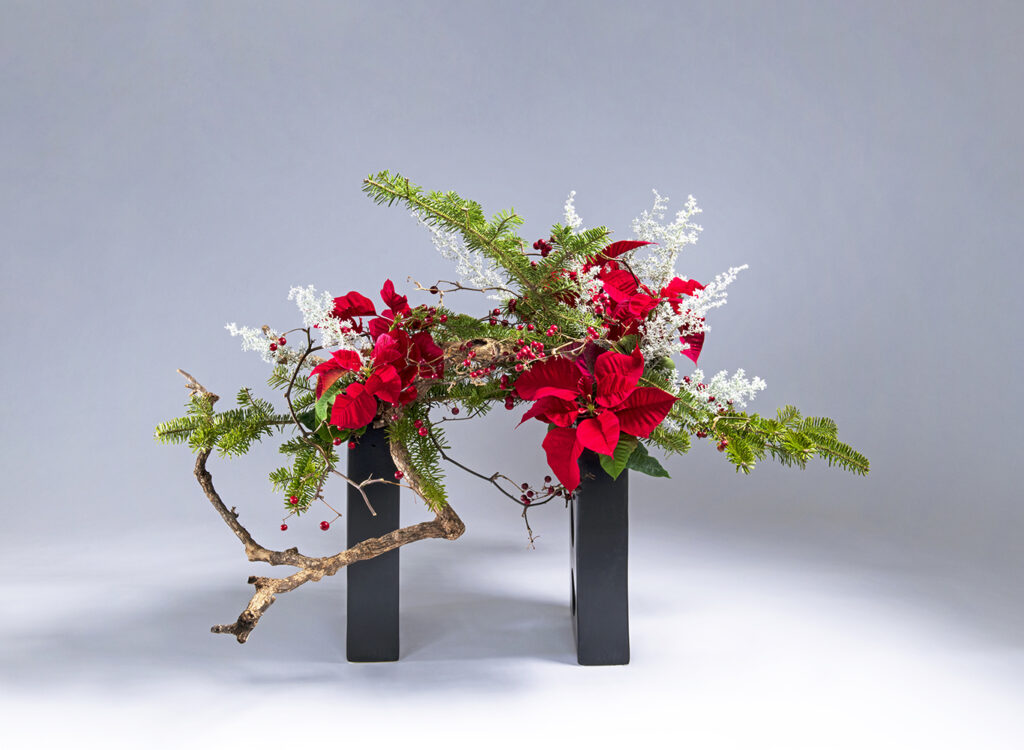
Q: You have many students both domestically and internationally. What do you value most when passing on the art of ikebana to the next generation?
I think it’s important to have a variety of approaches. Some people value classical styles, while others pursue avant-garde expressions. I feel that the diversity of these schools is what makes ikebana so valuable. If we were to unify everything under a single approach, I think it would lose its appeal. It’s hard to explain this clearly, so when students ask me, ‘What are the differences between ikebana schools?’ I often use fashion magazines as an analogy.
Q: Fashion magazines?
Fashion magazines each have their own unique ideas and editorial policies, which are reflected in the tone of the magazine and the styles they propose. Ikebana is the same; each school has its own characteristics and ideas. Some people prefer the Ichiya-style, while others seek a more classical school. I believe that the diversity of ‘there are so many ways to present it’ is the charm of ikebana.
Q: Are there ‘trends’ or ‘fads’ in ikebana, just like in fashion?
I feel like there is a certain flow to it. As for trends, I think they were more pronounced in the past, with each era having its own distinct style. For example, in the 1960s, expressions influenced by modern art emerged, and there was a movement to bring ikebana closer to modern art. However, when such expressions went too far, people started asking, ‘Is this sculpture?’ or ‘It doesn’t use any flowers at all, so is this really ikebana?’ Once that happens, a trend emerges that focuses on the expression of plants themselves, such as using decaying plants, to confront the very existence of plants. And once that trend subsides, more people begin to prefer traditional styles, saying, ‘Classic ikebana is nice too.’ In this way, I think the expression of ikebana has evolved while oscillating between different eras.
Q: How does the coexistence of tradition and new styles work?
In ikebana, the style established 500 to 600 years ago is still being passed down today. From there, various new styles have emerged, each branching out like leaves and coexisting. Rather than opposing each other, schools naturally incorporate the spirit and ideas of classical ikebana while expressing them in the style of free ikebana.
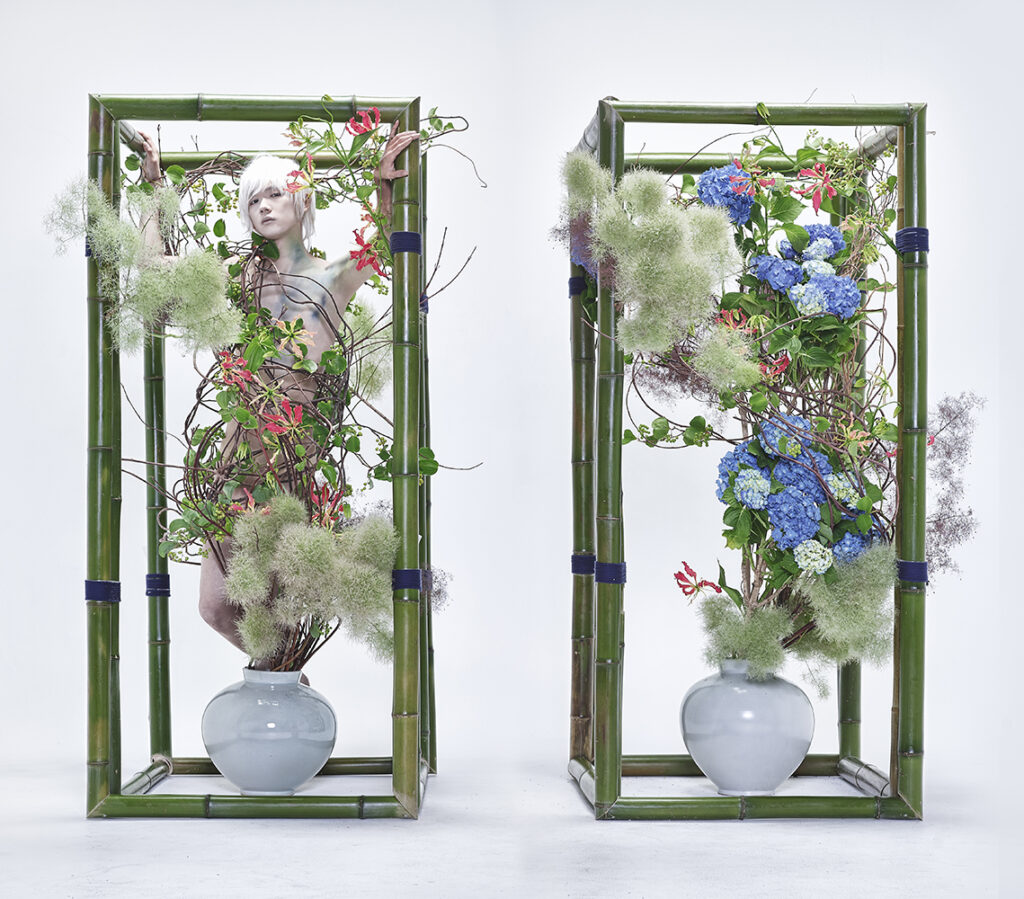
Q: Ikebana has a strong image as a traditional culture, and I had the impression that it was somewhat rigid, but in reality, it is much more flexible and free than I had imagined.
Ikebana is a truly fascinating world once you step into it. I think one of the charms of ikebana is that anyone can become an artist. For example, someone who studies dance can express their steps through ikebana. If you love wine, you can arrange flowers themed around Burgundy wine. Everything you have gained in your life can be sublimated into ikebana. Gender and age don’t matter, and there’s no need to be constrained by gender or generational stereotypes. For example, there are men with strong, large hands who create cute works, and there are petite women who create incredibly powerful works. As you move your hands, your ‘individuality’ and ‘worldview’ naturally come through in your expression.
Q: What is necessary to express your individuality through ikebana?
Not limited to ikebana, I think it is important to first learn the basics thoroughly in order to express individuality. Without a solid foundation, techniques tend to become one-dimensional. While there are now methods for self-study available on platforms like YouTube, learning under a teacher provides more information and helps skills develop more effectively. Regardless of the school chosen, learning from the basics expands the enjoyment and possibilities that follow.
Q: What is the ideal future of ikebana as envisioned by Mr. Kasuya?
In the past, many people learned ikebana as part of their bridal training. I want to dispel that image and create a situation where it becomes commonplace to think, ‘To cultivate creativity, you have to learn ikebana.’ For example, in old Japan, the purpose of a room was not fixed. Even without a bedroom, you could lay out a futon to sleep, and by putting away the futon and bringing out a low table, that space could become a tea room. By placing screens or folding screens, you could divide the space and use it like a separate room. In this way, people used to flexibly utilise a single space, but somehow, the purpose of each room became fixed as ‘this is the bedroom’ or ‘this is the living room,’ making it difficult to use them in other ways. By being bound by fixed forms, our thinking has become rigid. The strength of the Japanese lies in their ability to make use of what is in front of them and freely arrange it with imagination. However, I feel that this has weakened somewhat in recent years. Perhaps it could be described as a lack of ‘ikebana power.’
Q: ‘Ikebana power’! That’s a good phrase.
As with cooking and architecture, Japanese people have traditionally been skilled at extracting the essence of other cultures and arranging it in their own way to create something completely new and original. Ikebana helps to nurture such creativity. Identifying the characteristics of floral materials and considering how to bring out their individuality is something that anyone can do, regardless of talent. Plants can be found anywhere in the world, so if you can arrange ikebana unique to that region, it will greatly expand the enjoyment of your travels.
Q: It is important to start ikebana without overthinking it.
Even just trying it out is fine. I would be happy if people could experience the joy of arranging flowers. Since I decided to make ikebana my career, I have always believed that the most important thing is to pass this culture on to the next generation. I think it is more important to promote the industry as a whole and spread the appeal of ikebana than to promote myself. That belief is what drives me to continue my activities.
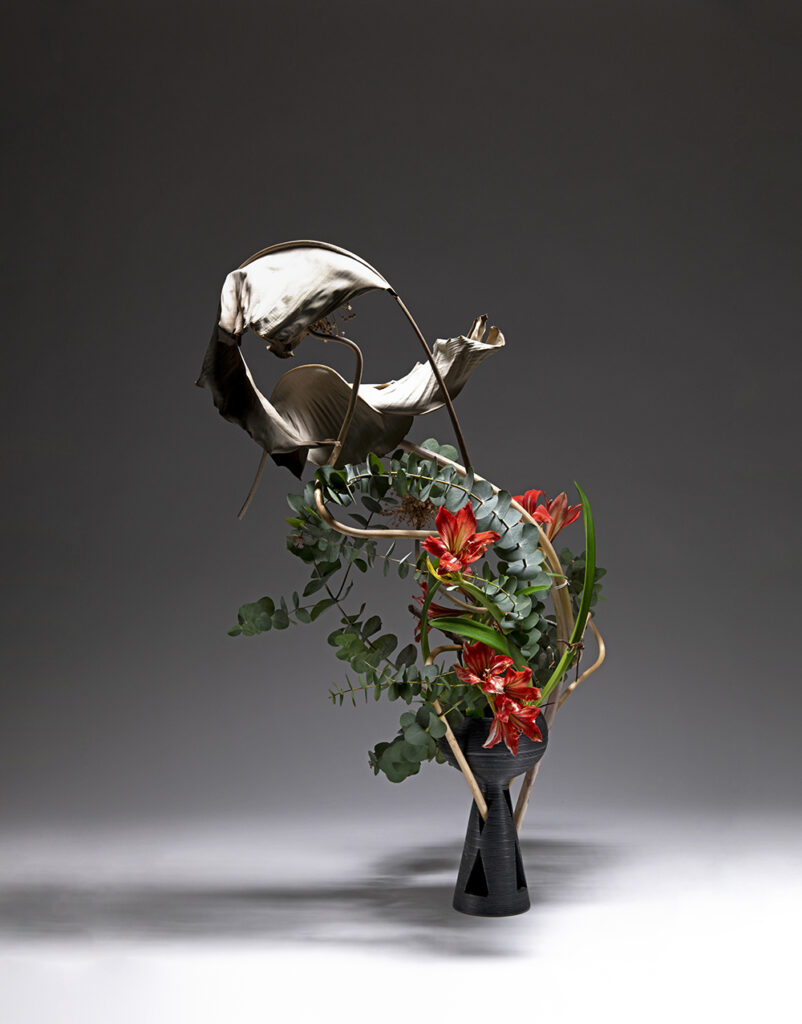
Q: Please tell us about the works featured in this article.
Focusing on the ‘nature of life,’ which is one of the essences of ikebana, I combine dried and fresh flowers to express the ‘vibrancy of life’ that lies within that boundary. The stems of alliums, which have lost their colour but still form graceful curves. The leaves of augusta, which create a new kind of beauty as they wither. Despite losing moisture and undergoing transformation, these elements exude a strong sense of ‘life.’ I added contrast by incorporating the vibrant red of the amaryllis, symbolising the vitality of life, and the eucalyptus, which retains a dull colour despite being a fresh flower. By layering the distinct textures of life emanating from both withering and living elements, this work seeks to express the beauty that exists between time and existence.
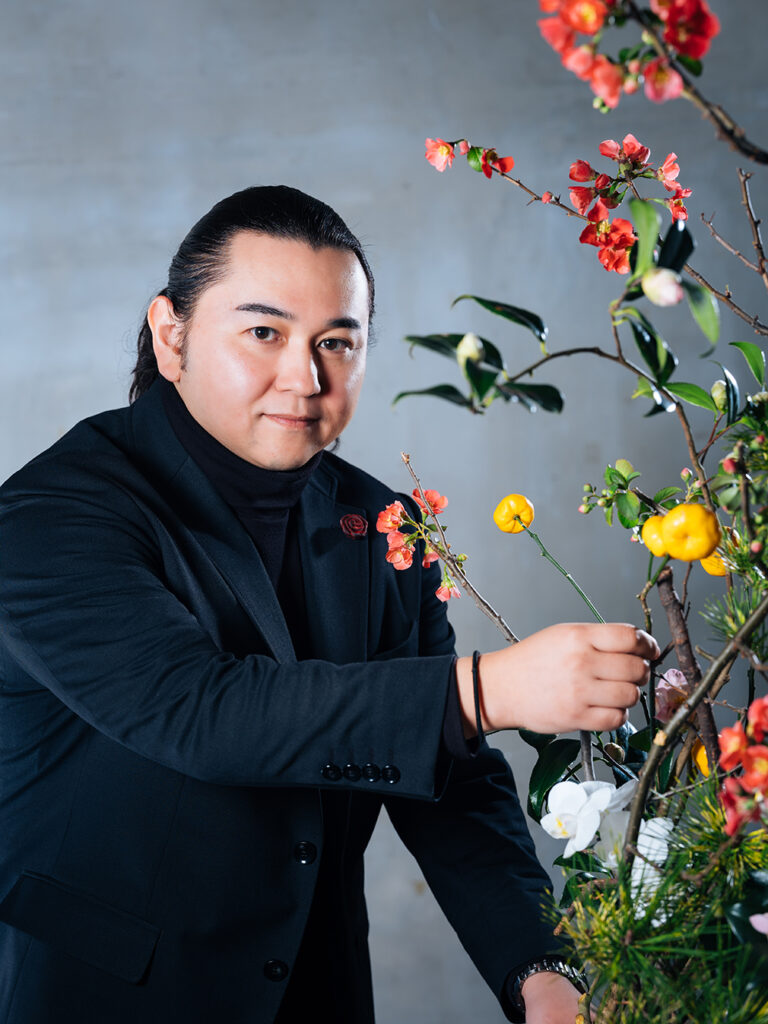
PROFILE
Ikebana Artist / Fourth Generation Head of the Ichiyo-style Ikebana School Naohiro Kasuya
Born in 1980 as the second son of the third generation head of the Ichiyo-style Ikebana School, Akihiro Kasuya. He began studying under his father from a young age. After graduating from university, he moved to the United States in 2004 to study industrial design. He actively participates in exhibitions within and outside his school, holding solo exhibitions and collaborating with artists from other fields. He is also dedicated to promoting ikebana overseas, conducting demonstrations at the Metropolitan Museum of Art in New York and in other countries such as the United States, South Africa, and Ukraine, among many others, making his overseas activities a topic of interest.

